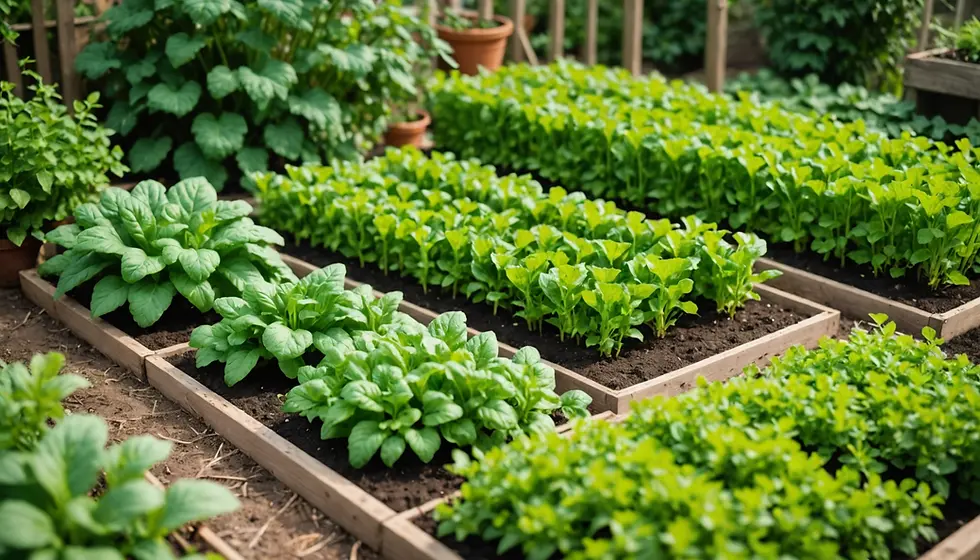How to Successfully Grow a Vegetable and Fruit Container Garden Indoors If You Do Not Have an Outdoor Space for Them
- Crountryside Living
- Feb 6, 2024
- 4 min read

Growing a vegetable and fruit container garden indoors can be a great way to enjoy the fresh taste of homegrown produce even if you don't have an outdoor space. With the right knowledge and setup, you can successfully cultivate a variety of plants indoors, even in limited spaces. In this guide, we will provide you with step-by-step instructions on how to successfully grow a vegetable and fruit container garden indoors.
Step 1: Choose Your Plants
The first step in growing a vegetable and fruit container garden indoors is to choose the right plants for your setup. Consider selecting plants that are well-suited for indoor gardening, such as leafy greens (lettuce, spinach), herbs (basil, parsley), compact varieties of tomatoes or peppers, and small fruits like strawberries. These plants tend to thrive in containers and require less space to grow. Here are some factors to consider:
- Light: Assess the amount of sunlight available in your home and choose plants that thrive in similar lighting conditions. Some plants, such as herbs, can thrive in low-light areas, while others, such as tomatoes, require ample sunlight.
- Freshness: Consider how quickly you would like to enjoy the produce. Some plants, such as leafy greens, can be harvested quickly, while others, like fruit trees, take longer to grow and produce fruit.
- Space: Assess the amount of space available for your container garden and choose plants that are suitable for the container size and layout.
Step 2: Prepare Your Containers
Once you have chosen your plants, it's time to prepare your containers. Here are some steps to follow:
1. Clean and Sterilize: Clean your containers to remove any dirt or debris. Sterilize them by soaking them in a solution of bleach and water, or using a commercial disinfectant.
2. Add Soil: Fill your containers with a rich, well-drained soil mixture specifically designed for container gardening. Ensure the soil is moist but not waterlogged.
3. Plant Your Seeds or Transplants: Plant your seeds or transplant your plants according to the instructions provided on the packaging. Gently press the soil around the roots to ensure good contact.
Step 3: Provide Adequate Light
Adequate light is essential for the success of your vegetable and fruit container garden indoors. Follow these steps to ensure adequate light:
- Choose the Right Location: Place your plants in an area of your home that gets sufficient sunlight. This could include a sunny windowsill, a south-facing porch, or a grow light setup.
- Maintain Distance: Leave enough space between your plants to allow for proper air circulation. Overcrowding can lead to problems with pests and disease.
- Protect from Direct Sunlight: If your plants receive too much direct sunlight, consider using sheer curtains or blinds to filter the light. This can help to prevent sunburn and crop damage.
Step 4: Water and Fertilize
Proper watering and fertilizing are essential for healthy plant growth. Follow these steps to ensure your plants receive what they need:
- Water Regularly: Check the moisture level of your soil regularly and water your plants when needed. Avoid overwatering, as this can lead to root rot and other problems.
- Apply Fertilizer: Use a water-soluble fertilizer designed specifically for container gardening.
Follow the instructions on the packaging to apply the fertilizer at the recommended frequency.
- Mulch: Mulch around the base of your plants to conserve moisture, suppress weed growth, and protect the roots.
Step 5: Control Pests and Diseases
Pests and diseases can pose challenges to an indoor vegetable and fruit container garden. Follow these steps to keep your plants healthy:
- Inspect Regularly: Inspect your plants regularly for any signs of pests or disease. Remove any affected leaves or fruits to prevent further spread.
- Apply Natural Pest Control Measures: Consider using organic pest control methods, such as neem oil or insecticidal soap, when needed. Avoid using chemical pesticides, as they can harm your plants and the environment.
- Prevent Diseases: Practice good sanitation by regularly removing dead or diseased plant material from your containers. Keep the area around your plants clean and free from debris.
Step 6: Harvest and Enjoy
Once your plants reach maturity, it's time to harvest and enjoy the fruits (or vegetables) of your labor. Follow these steps to harvest your plants:
- Check for Ripeness: Pay attention to the ripening times of your plants and harvest them when they are ready. This will depend on the specific variety you are growing.
- Carefully Remove Produce: Use sharp scissors or pruners to cut the produce from the plant, being careful not to damage the roots or other healthy parts.
- Store Properly: Store your harvested produce in a cool, dry place to extend its shelf life.
Some vegetables, such as leafy greens, can be stored in the refrigerator.
Growing a vegetable and fruit container garden indoors can be a satisfying and rewarding experience, even if you don't have an outdoor space for gardening. By choosing the right plants, preparing your containers, providing adequate light and water, and controlling pests and diseases, you can successfully cultivate a variety of vegetables, fruits, and herbs in your home. So, grab your containers and start growing your own delicious produce today!




Comments